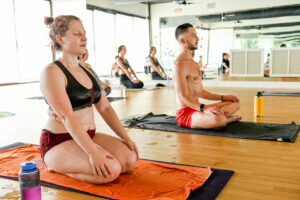What can science tell us about boosting mental focus, endurance and resilience?
Over the past couple of years, with the pandemic, we’ve all been through a lot. And it probably feels like your stamina is waning. Dr. Andrew Huberman, a neuroscientist professor at Stanford university, studies mental focus in his lab. He works with other scientists who study performance, mental clarity, and other physical performance science to help people to increase their physical and mental performance.
In a recent Huberman Lab podcast called “How to Build Endurance in Your Brain & Body,” Dr. Huberman talks about ways to create better mental focus and build stamina so that you can endure difficulty both mentally and physically. He talks about the science behind how physical practices can help build endurance, resilience, and stamina. And he gives us protocols to follow in order to do this for our mind and body.
Even with concerns lessening, we still need to address the things that happened so that our mental health can improve as a society. But, how do you address that?
Using 90-minute yoga, you can increase willpower and resilience, build and increase endurance, and increase mental focus. Because your mind and body work together.
Let’s dig into what that looks like.
Why 90 Minute Yoga?
Build Endurance
Long-duration physical exercise doesn’t just help you build endurance for physical activities. It also helps you build mental endurance, willpower, and focus.
Dr. Huberman says, “continuous effort of any kind has a biological cross-over to your mental performance, and your brain can perform focused work for longer periods of time.” A long run, a long swim, a long bike ride, a long yoga class “builds on fuel utilization in the muscles and activity of neurons in the brain. That’s activity at less than 100% of your maximum oxygen uptake – your VO2 max. Your ability to continue that effort depends on the efficiency of that movement.”
He continues to note that if you’re trying to learn a new skill, and if you want to spend more time doing it, make sure you’re practicing a long-duration endurance exercise at least once a week. If you’re going through something emotionally, and you want and need to endure, make sure you’re practicing a long-duration exercise at least once a week.
Why Does Long Endurance Exercise Work for Your Body and Mind?
It’s because you’re building the capillary bed in your brain to fuel your ability to continue your effort on any given activity. That capillary bed brings more oxygen to your muscles and your brain. You can build the number of these capillaries when you practice long-duration exercises. The more capillaries you build into the muscles, the more oxygen you have for the muscles and the mind. Dr. Huberman says, it’s like you’re building a “sprinkler system of oxygen” for your body and mind.
Decrease Stress
Exercise affects your heart rate; everyone knows this; as you exercise, your heart rate goes up, and when you rest, it decreases. As you exercise, you strengthen your heart, and it doesn’t need to pump as hard to do its job. This can also impact your resting heart rate and decrease it.
This also impacts your parasympathetic and sympathetic systems. When your sympathetic system takes over, you’re often in a state of stress that’s causing fight or flight and anxiety.
While your parasympathetic system can help keep things calm and relaxed. Living in a constant state of fight or flight because of chronic stress is bad for your health.
One way you can see that your sympathetic nervous system is in charge is by checking your resting heart rate. Your sympathetic nervous system releases hormones that will speed your heart up.
If you have a high heart rate, it’s likely you’re in a state of stress, and your sympathetic system is in charge. Exercise can help you decrease that stress and, in essence, allows you to act out the fight or flight response.
Decreasing stress helps you sleep better, focus better, and more.
How Realistic is it to Practice 90-Minute Yoga Each Week?
All of us live busy lives. Sometimes fitting in a 90-minute yoga class can feel impossible. Not to mention the thoughts of wanting to quit mid class.
However, there are reasons this type of class exists. For example, the 26 & 2 hot yoga classes are traditionally 90 minutes.
When this style of yoga was created, it implemented a routine that included 26 Hatha yoga postures and two pranayama breathing exercises. During the course of the class, you complete each of the Hatha yoga poses twice.
Each pose has various benefits, and the first set helps to prepare your body. The second set helps to ensure you get maximum benefits of each posture. In addition, during the second set, your body will go deeper.
Dr. Huberman says each time you perform a long-endurance exercise, it builds your ability to do it again. As a matter of fact, he stresses that adding minutes to a shorter-term exercise can build up to the stamina you need for a long-endurance exercise.
Stop Wasting Mental Energy and Increase Willpower
How long are you spending thinking about whether or not to do the exercise in front of you? Spending time debating over whether or not you should do it, takes energy that you could spend just doing it.
Stop arguing with yourself about whether or not you should schedule a 90-minute yoga class. Schedule it, put it on your calendar, and show up ready so you can enjoy your class.
“Our desire to continue…or willingness to continue is mediated by events happening between our two ears.”
~ Dr. Andrew Huberman
What Yoga Class Should You Take?
If you’re convinced that you should sign up for a 90-minute yoga class, then there’s another question you need to answer. What class should you take?
90-Minute 26 & 2 Hot Yoga Class
This is the best endurance-based exercise you can add to your workout regiment. This is because of how the class helps you to recover at the end.
According to Dr. Huberman, you can accelerate your workout recovery by downshifting at the end of your training. This means that you should not just finish your training and hop on your phone or right into your car.
You need to take a minimum of five minutes to do slow pure nasal breathing. Or, you can just lie down and zone out.
Every 26 & 2 Hot Yoga class ends with Savasana. 
In addition, Savasana can accelerate your mind and body recovery between classes, and will help build endurance, mental focus, and resilience for the rest of the week.
Sign Up for Your Yoga Class Today
A 90-minute yoga class can bring many benefits to your mind, body, and soul. As you work to build endurance and increase willpower, don’t waste time arguing with yourself about whether or not to do it.
Toss your yoga pants, socks, and mat in your gym bag, and sign up for a class today.
 -ing our NEW! Community Classes!
-ing our NEW! Community Classes!





